| Burma Thailand Railway Camps Note Distances shown to nearest Kilometre | Distance from Thanbyuzayat (in kilometers) | Distance from Nong Pluduc (in kilometers) | Notes |
| THANBYUZAYAT | 0 | 415 | 4700 A Force arr AUG 42; 200 US Fit Grp arr OCT 42 with 1500 AUS; NOV 42 1400 Dutch arr; DEC 42 1000 Grp 5B arr; JAN 43 1000 Dutch arr; JUN 43 many moved up-country |
| Kandaw (4 Kilo) | 5 | 410 | Green Force commenced work 1st October 1942, the first to start work on the Burma end |
| Wagale (Wegare or Sin ‘new’ Thanbyuzayat) | 8 | 406 | Dutch Force first occupied Wagale |
| Thetkaw (Tettoku) | 14 | 400 | Captain Claude Anderson (SMO) wrote a report to the SMO “A” Force Lt Col Hamilton from here 31 JAN 43 |
| Hlepauk (Alepuak or Raboa ) | 18 | 396 | The US Fitz Party spend much of its TBR time here; Anderson Force OCT 42 to JAN 43. Group 5A (THARP) from 40 kilo on JAN 1943; Br Sumatra Bn arr MAY 43 |
| Kunhnitkway (Konnokoi) | 26 | 389 | Ramsay Force 20 DEC1942 to the 18 MAR 43; first camp for Tharp grp in JAN 43 |
| Rephaw (Repo or Reptu) | 30 | 385 | After repeated bombings at Thanbyuzayat, 30 Kilo became Base Hospital for No 3 Group, subject to strafing raids |
| Tanyin (35 Kilo) | 35 | 380 | Williams Force from Java (884 POWs) arrived October 1942. Joined by Anderson Force January 1943 to become No 1 Mobile Force |
| Betetaung (Bekitan Beke Taung)) | 40 | 374 | Black Force including 184 Americans (Fitz) arrived October 1942 |
| Anankwin (Anaqueen) | 45 | 370 | No 1 Mobile Force moved here while laying the rails & sleepers before moving to the 60 kilo camp |
| Thambaya | 50 | 365 | F Force Hospital Camp est AUG 43. 1700 desperately sick were brought here from Thailand, of these 700 died in less than 6 months.; 576 graves |
| Khonkhan (55 Kilo) | 55 | 360 | Base hospital under renowned Australian Surgeon, Colonel Coates, he performed countless leg amputations on ulcer patients. |
| Taungzun (Tanzu) | 57 | 358 | When No 1 Mobile Force arrived in May 1943 they had to bury dead Asians found in the huts, Cholera victims, this was the start of an cholera epidemic among POWs |
| Kami Mezali (North) | 65 | 350 | 3 Group head quarters |
| Mezali (70 Kilo) | 69 | 346 | No 1 Mobile Force moved here from the 60 kilo in July 1943 previously occupied by Burmese it was in a filthy condition with deep mud every where, a total clean up was needed before it could be occupied. |
| Meiloe (75 Kilo) | 75 | 340 | Black Green & Ramsay Forces arrived 18th March 1943 |
| Apalaine (80 Kilo) (aka Phadong or Aparain) | 80 | 337 | Group 5A arr MAR 43; No 1 Mobile Force arrived in August; No 5 Group (THARP) were still in occupation, No 5 Base Hospital |
| Apalon (82 Kilo) | 83 | 332 | Site of one of the seven steel railway bridges in Burma; AUG 43 evacuated to NgPlaDuk & ChgKai |
| Lawa (85 Kilo) | 85 | 330 | Tharp Group arr 15 MAR 43; APR 43 all moved to Kilo 80 |
| Tadein (90 Kilo) | 90 | 325 | |
| Kyondaw (Kyando, Kando) | 95 | 320 | Transit camp for ‘F’ Force sick moving to Thambaya. |
| 98 Kilo Camp | 98 | 317 | |
| Regue (100 Kilo) | 100 | 315 | Group 5A (THARP) May 43 almost all of the US deaths occurred here or at the 80 K ‘hospital’. |
| Aungganaung (Anganan) | 105 | 310 | A work camp housed Black, Green & Ramsay Forces in April 1943, later used as a grouping camp before the POWs were evacuated to Tamarkan in Thailand in JAN 44 |
| Paya Thanzu Taung (108 Kilo) | 108 | 307 | MAY 43 100 arr from Mezali; 200 No 1 Mobile Force arr SEP 43; JAN 44 most moved to Chan (K301) |
| The Three Pagodas | 108.5 | 306.5 | Border between Thailand and Burma. |
| Changaraya | 112 | 301 | F’ Force No 5 Camp for 700 British. 214 men who died here are buried in a single mass grave in Don Rak. F arr May 43; Burma-side workers arr NOV 43 from Apalon |
| Kami Sonkurai (N) | 115 | 299 | F’ Force No 3 Camp, originally 400 Australians. 1700 mainly Br sent to K50 hosp AUG 43. |
| No 1 Mobile Force Camp | 116 | 299 | Staging camp for Anderson and Williams combined Rail laying Force originally from Burma |
| Songkurai | 121 | 294 | ‘F’ Force No 2 Camp for 1,600 British. Site of the “Bridge of 600” a death camp 600 died here and another 600 when evacuated to Thambaya and Kanburi |
| 122 Kilo Camp | 122 | 293 | No 1 Mobile Force occupied this camp. |
| Shimo Songkurai (S) (SongKla or Keungkluay, Lower SgK) | 127 | 288 | F’ Force No 1 Camp of 1800 Australians. |
| Little Nikki | 131 | 284 | No 1 Mobile Force’s most southern camp. The US POWs worked in this area cutting wood for fuel until they were moved to KAN in 1944. |
| Tunnel Party Camp | 132 | 283 | Set up in 1945 POWs constructed defense positions for Japanese. |
| Nikki Camp (Nike) | 133 | 282 | HQ camp for ‘F’ Force. Lt/Col Dillon Force C.O. About 1000 POWs including 400 Australians. Some Malay Volunteers worked in this area, they were mostly British civilian business men. |
| Nikki Bridge Building Camp (Osaka Tai) | 134 | 281 | Prisoners here built bridge over the Ranti River |
| Lower Nikki (Shimo Ni Thea) | 139 | 276 | Original HQ camp for ‘F’ Force. |
| Thingomtha (aka Taimonta,Timortar Timonta ) | 142 | 273 | Pond’s Party (700 AUS of F Force) built a large bridge here. |
| Upper Konkoita | 145 | 270 | |
| Konkoita (aka Concreeta) | 152.13 | 263 | H Force No 4 Camp of Australians. 700 F and 200 H Force arr MAY 43 |
| Kurikonta | 157 | 258 | H Force No 1 Camp |
| Kroeng Krai (Klian Klai) | 165 | 250 | Six Australians were killed in a rock fall. 28 SEP 43 |
| Swinton’s Camp | 166 | 249 | |
| Dobb’s Camp | 169 | 246 | |
| Johnson’s Camp (also Tamuron or Tamuronpato) | 171 | 244 | |
| Tha Mayo Wood | 176 | 239 | Tamil-Indian workers occupied this camp during construction, later POWs worked on wood parties, fuel for locomotives |
| Tha Mayo (Tamajo or Tamazyo)] | 178 | 237 | |
| Nam Chon Yai (also Namajo or Namuchon Yai) | 186 | 229 | |
| Tha Khanun North | 190 | 225 | The thousands of romusha worked mainly in these Highlands camps between Hintok and Konkoita |
| Tha Khanun Base | 192 | 223 | HQ camp #4 |
| Tha Khanun | 193 | 222 | Mainly an Australian camp; many groups passed thru here for short periods. |
| Tha Khanun South | 197 | 218 | Lt/Col Pond’s Australian group worked in this area |
| Bangan | 201 | 214 | |
| Yongthi (Ong-thi or Onte) | 202 | 213 | Small group of D Force Australians and a small group of Dutch POWs. |
| Prang Kasi 211 kilo | 204 | 211 | Dutch Camp |
| Prang Kasi (Purankasi) | 207 | 208 | East of Railway Station |
| Prang Kasi South | 208 | 207 | British and Australian of D Force in a riverside camp south of railway station. |
| Linson (3 Camps) | 212 | 203 | Woodcutting camp set up here in December 1944. |
| Kui Mamg | 216 | 199 | Upstream from Hot Springs |
| Hindat (also Hindato) | 217 | 198 | Said to have had a Comfort Station for IJA. |
| Hindat West | 218 | 197 | River Camp 1 kilometre from station |
| Wang Hin | 223 | 192 | |
| Kuishi | 225 | 190 | Dutch prisoners worked in this area |
| Kui Yae (Kuie or Kui Yong) | 229 | 186 | Dutch prisoners worked in this area. 26 POW’s killed in Allied bombing raid 8 Dec 44 at K213. |
| Lin Tin (aka Rin Tin or Rinten) | 233 | 182 | Dutch prisoners worked in this area 1500 arrive FEB 43 including 500 Dutch; 300 to CK in NOV 44; |
| Kinsaiyok Main Camp | 244 | 171 | 1600 Dutch arr Feb 43; 500 moved to Kui Yea MAY 43;site of shooting of British POW. |
| Kinsaiyok Jungle Camp 2 | 247 | 168 | Site of rock quarry for rail ballast |
| Kinsaiyok Jungle Camp 1 | 254 | 161 | The original grave cross of an Australian who died here was found in 2000. |
| Kinsaiyok Jungle Camp 3 | 256 | 159 | |
| Hintock Cement | 258 | 157 | Barges bringing up barrel of cement unloaded here |
| Hintock River (2 Camps) (Hintoku) | 260 | 155 | |
| Hintock Road (3 Camps) | 261 | 154 | 800 arr MAR 43; Dunlop Force worked here on cuttings & Three Tier Bridge. Large number of deaths here from cholera. |
| Malay Hamlet | 262 | 153 | H’ Force camp of men to reinforce work on Hellfire Pass. 216 deaths in about 10 weeks. [75x25m] |
| Kannyu No 3 | 263 | 152 | D-Force worked on the infamous Hellfire Pass |
| Upper Kannyu | 264 | 151 | HellFire Pass |
| Lower Kannyu (3 Camps) | 264 | 151 | Dunlop Force initially constructed one of these camps. |
| Kannyu South | 265 | 150 | |
| Tampi (Tampines) | 267 | 148 | |
| Tampi South | 272 | 143 | D Force Workers |
| Tonchan Springs | 275 | 140 | |
| Tonchan Central | 276 | 139 | |
| Tonchan South | 284 | 131 | H Force commenced work here on arrival in May 1943 |
| Tarsao Hospital | 290 | 125 | HQ and hospital camp for D Force. Transit camp for workers marching north. |
| Wang Yai | 290 | 125 | HQ camp #3 |
| Pukai | 296 | 119 | |
| Wang Pho North | 299 | 116 | |
| Wang Pho Central (WanPo, Wampo, or Wanpou) | 302 | 113 | |
| Wang Pho South | 302 | 113 | Camp on west of the river. Site of the still operating Wampo Viaduct where trains cross with tourists |
| Arrow Hill (Wang Sing or Arruhiru) | 305 | 110 | [At Hit] |
| Non Pradai | 313 | 102 | |
| Tha Kilen | 317 | 98 | |
| Ban Khao | 327 | 88 | Dutch POW discovered neolithic artifacts here and post war returned to find a major neolithic site. |
| Wang Takhain | 334 | 81 | |
| Wang Yen (WonYen or Tapon) | 340 | 75 | current RR station; |
| Wang Lan (Wanran) | 346 | 69 | |
| Chungkai (sometimes Khoa Poon) | 355 | 60 | A work camp then one of the main hospital camps for Thailand POWs, now the site of a War Cemetery. [see info below] 800 British officers tfx’d here from Ban Pong in NOV 42. |
| Tha Makhan | 359 | 56 | Commencing 26 October 1942 under Colonel Phillip Toosey British & Dutch POWs built two bridges a wooden one and a steel one across the Kwae Yai;; HQ camp #2 |
| Kan’buri Base | 362 | 53 | Headquarters of 9th Railway Regiment, in charge of the Thailand end of the construction. F & H Force Hospital camps. |
| No 2 Base Camp | 364 | 51 | Aerodrome Camps No’s 1 & 2. Officers Camp 1944 |
| Kan’buri Hospital | 365 | 50 | Hospital Camp for F & H Forces. |
| Tha Muang (aka Thamwan) | 376 | 39 | Base camp for many railway workers at the end of construction. Dutch lived here until 1947. |
| Tha Reua (TaruaNoi or Talua) | 389 | 26 | Transit camp for prisoners from Singapore marching north. |
| Ban Pong | 412 | 3 | First transit camp for prisoners from Singapore |
| Nong Pladuc | 415 | 0 | Start of construction in June 1942 by British POWs from Singapore; HQ camp #1 |
| Rod Beattie of the TBRC, kindly made available all his data for researching of this project. He has spent many years exploring and researching railway sites and has built a Railway Information Centre in Kanchanaburi. |
| https://www.britain-at-war.org.uk/WW2/Death_Railway/html/camps.htm |
Hellfire Pass (shown as Kannyu in the chart above) is 150 Km from BanPong where the POWs and romusha arrived by train. In a historical footnote, the Bataan Death march was about 100 Km in total. Most of the latter arriving TBR workers trekked a minimum of 150 Km to their assigned place of work. The end of the Thai sector at Konkoita is 260 Km from BanPong.
Here is an interesting look at how the TBR route crossed various rivers and tributaries particularly in Burma:
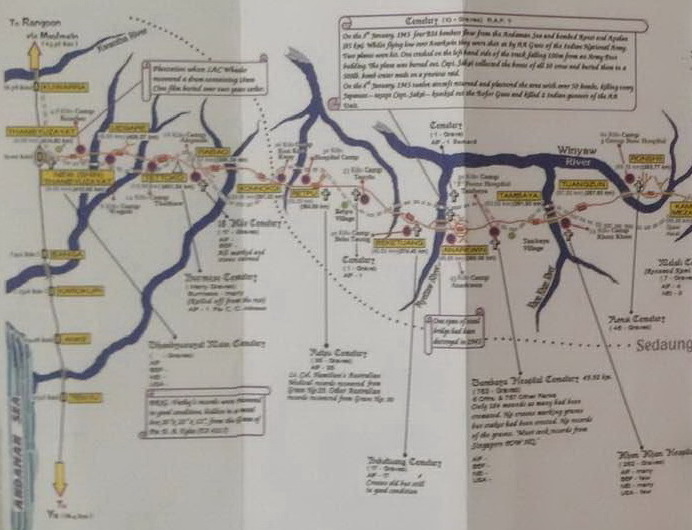
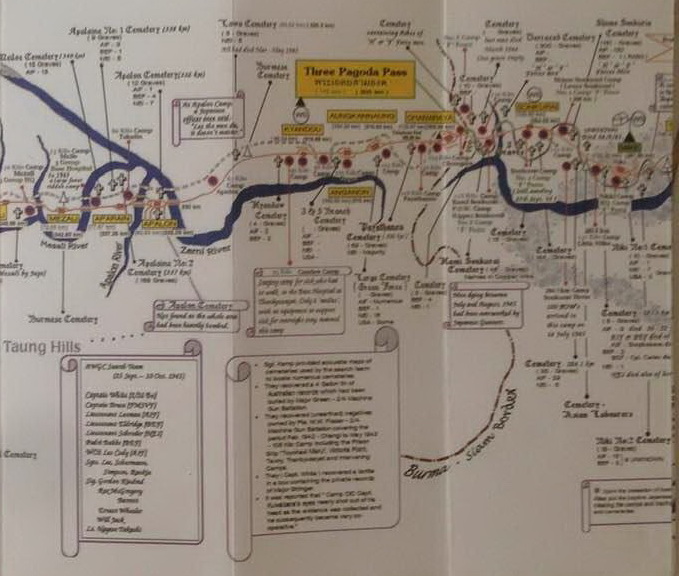
ChungKai (listed as Km 60 from NongPlaDuk on the above chart) is in an interesting and seems to have gone through a series of iterations. It was initially a mainly British POW camp and the first to actually perform what would be the standard TBR construction. The POWs there was largely officers who seemingly arrived as the result of some sort of administrative error early in the movement of POWs out of Singapore. Their first task was to build a large berm to level the railway as it began to parallel the Kwae Noi River. Next, came the first of many ‘cuttings’ through limestone outcroppings that blocked the path. Finally, a few small bridges spanned the depressions and streams in the area. Once this was completed these men were leap-frogged further west to continue construction.
[just about everything these men built is still present and can be toured today, if you are up for a bit of a trek.]
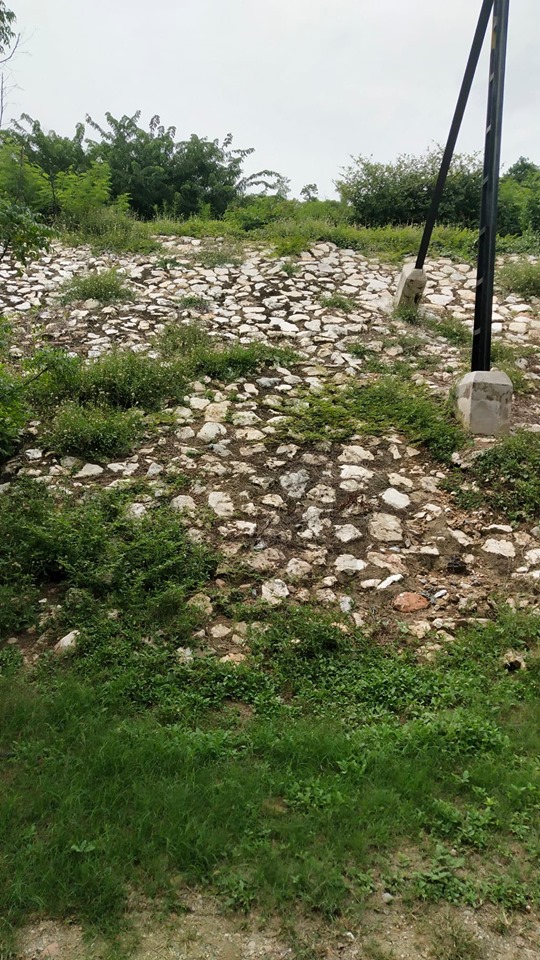
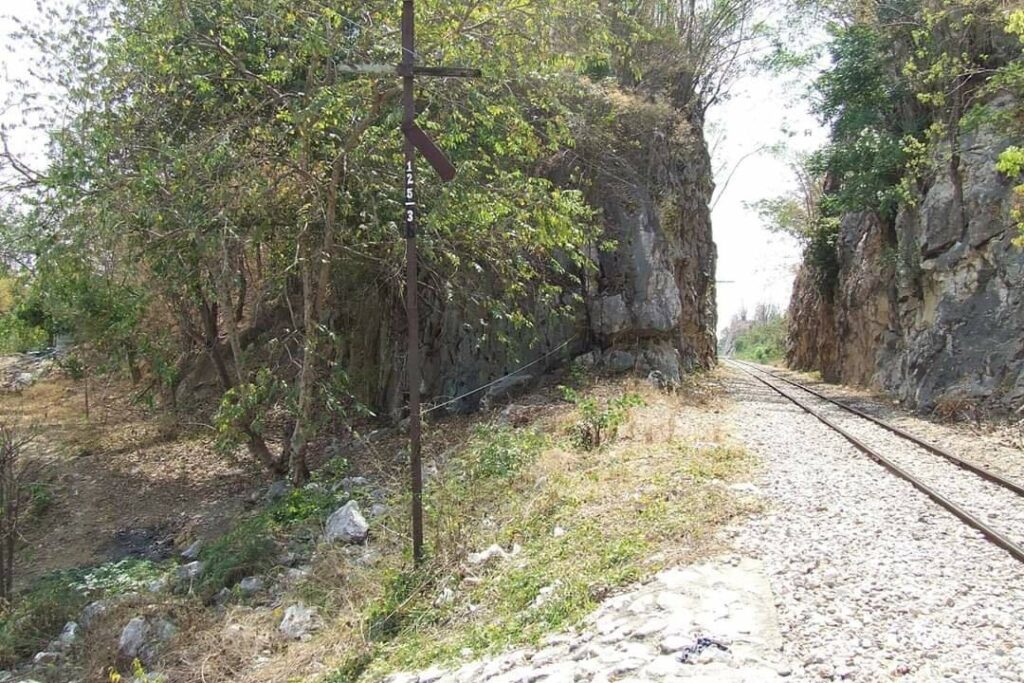
At this point, ChungKai seemingly became a transit camp. While LtCol Toosey’s team was building the bridges, large numbers of POWs and later romusha were arriving by train at BanPong. They would be brought to Kanchanaburi by truck or made to walk the 50+ Kilometers. At the walled city the would be transported across the rive by barge and pass through ChungKai until they moved westward to their assigned work places.
As conditions on the TBR deteriorated, ChungKai then became a designated hospital camp. Essentially this meant that men who were not expected to survive were transported there to die. It is reported that most of those buried in the CWGC cemetery that exists there today, dies at that hospital.
Finally, there is a suggestion that in 1944 it became a quarantine camp. There had been cholera outbreaks at a number of the camps in the Thai Highlands. The Japanese were deathly afraid of cholera and took great measures to contain these outbreaks. This included placing bodies on funeral pyres who were not yet dead.
By the time the TBR was completed in OCT 1943, just about all of the POWs were in Thailand. Working from the closest, they were slowly consolidated to the main Kanchanaburi (KAN) camps. The US POWs were largely in the SongKurai area cutting wood for fuel and were among the last to be brought to KAN. Since this is the area that had had the cholera outbreaks, the POWs arriving from that area were likely held at ChungKai to insure that cholera was not introduced into the larger camp. We know that LTC Tharp had buried a briefcase of documents on the suspicion that it may be confiscated upon their arrival in KAN. During this same period, the hospital continued to function.
Located near the confluence of the Kwae Noi and the Mae Klong, ChungKai continued to operate as a camp even as all the others were abandoned to the jungle. Immediately post-war Tharp dispatched a team to retrieve his briefcase of rosters and records. Thanks to those documents. we have many maps of the up-country graves of the US POWs as well as rosters and notations about date, place and causes of their death.
In a magazine article, Ramsey provided a Dutch map of the entire length of the TBR:
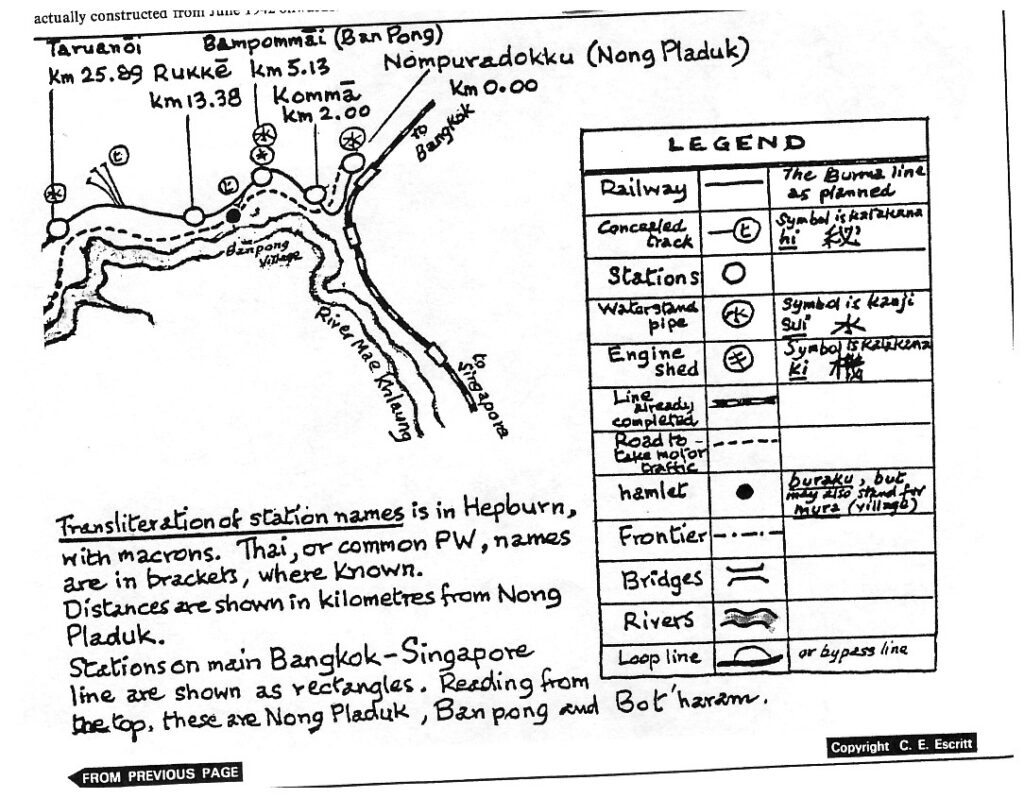
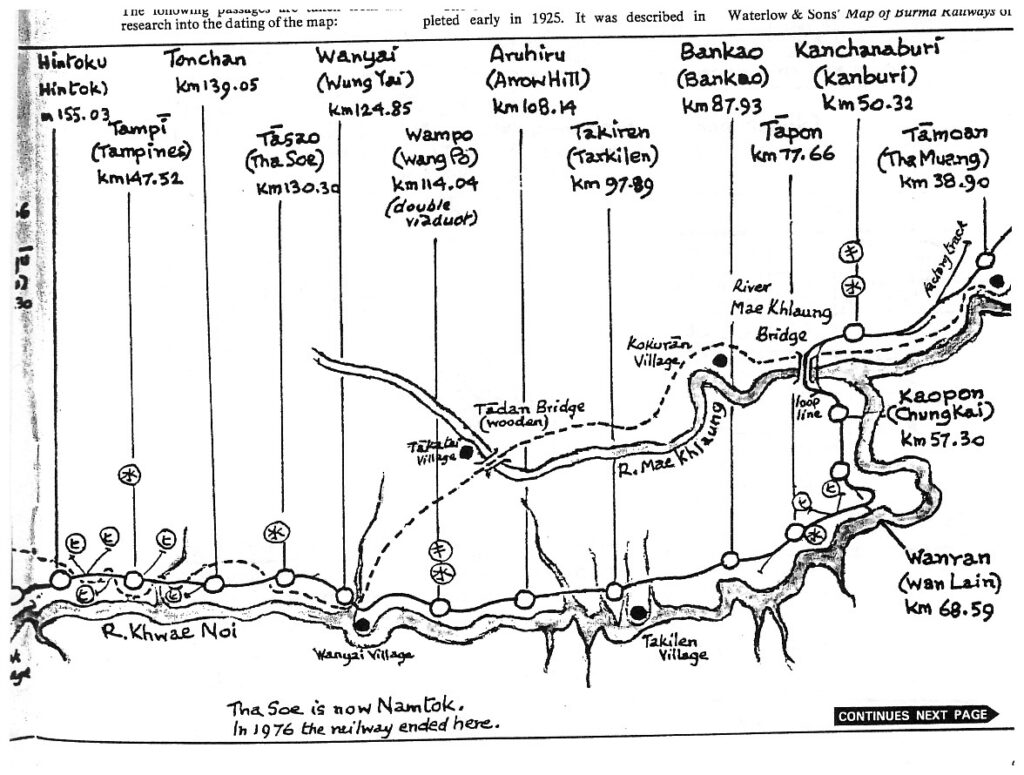
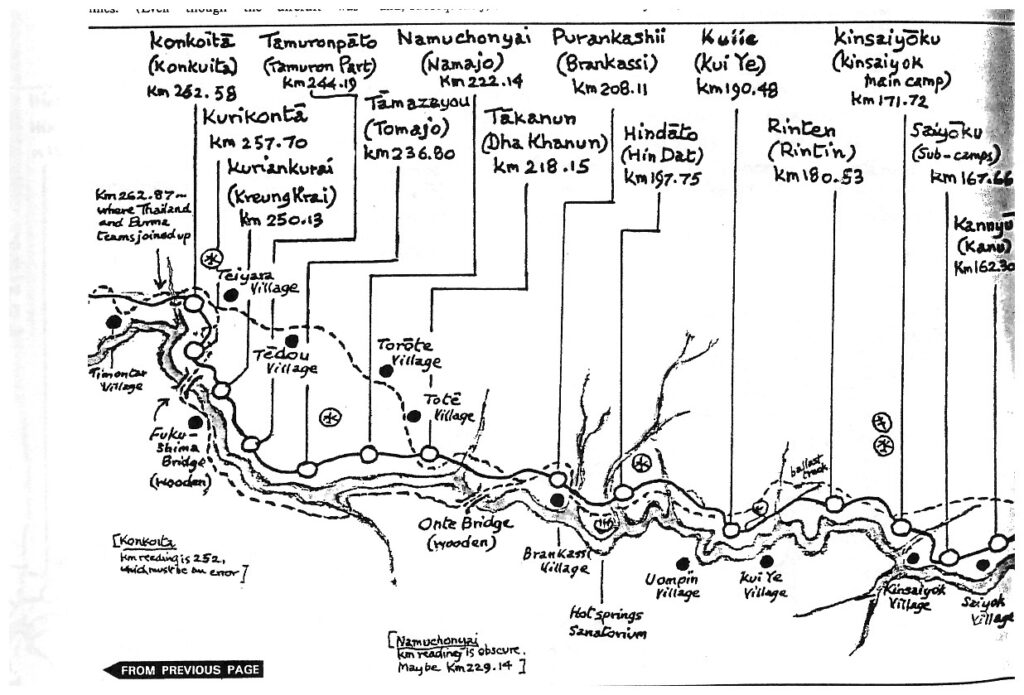
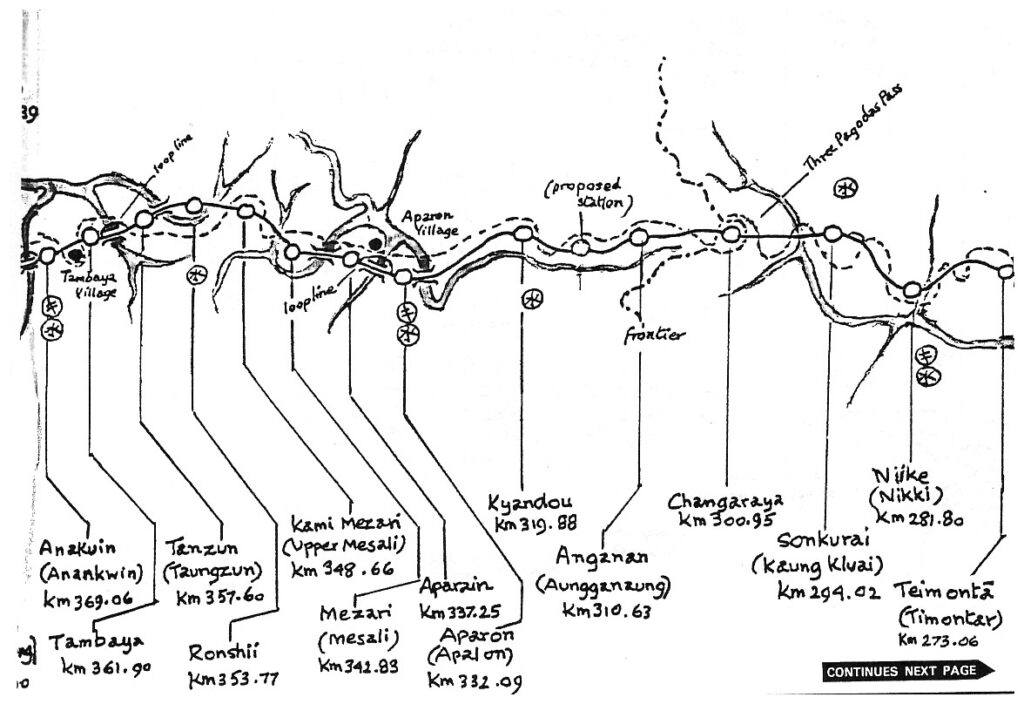
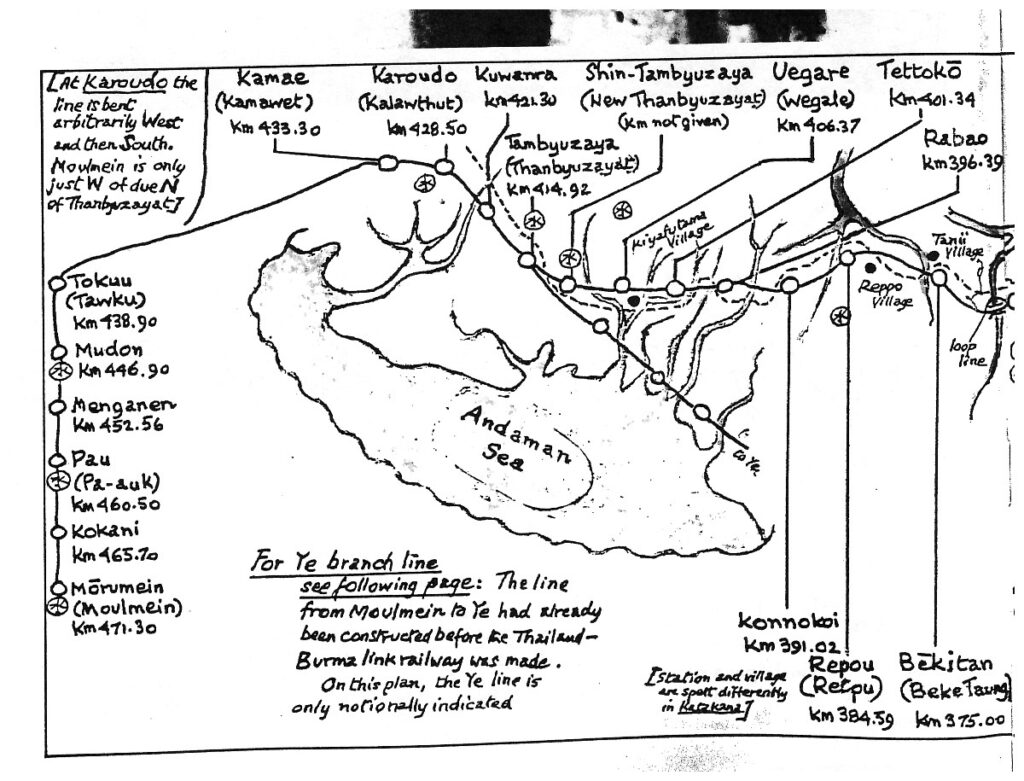
Below is a chart provided on the Manssell website accounting for the movement of POWs:
| Work Party | Moved | Place | British | Australian | Dutch | USA | Total |
| A Force | 14-May-42 | Burma | x | 3000 | x | x | 3000 |
| Medan Force (Br Sumatra) | 20-May-42 | Burma | 498 | 2 | x | x | 500 |
| No 1 Group (Maj Sykes) | 18/26-June-42 | Thailand | 3000 | x | x | x | 3000 |
| No 2 Group | 9/15-Oct-42 | Thailand | 3250 | x | x | x | 3250 |
| No 3 Group (KL Party) | 14-Oct-42 | Thailand | 791 | x | x | x | 791 |
| Williams Force | 16-Oct-42 | Burma | x | 1497 | 111 | 190 | 1800 |
| No 4 Group (Sime Rd Party /Toosey) | 17/22-Oct-42 | Thailand | 2600 | x | x | x | 2600 |
| 5 Group 2 | 20-Oct-44 | Junyo Maru sunk | (58) | 3 plus (4200 Javanese) | (1600) | (8) | 680 survived |
| Y Party (Adam Rd; Maj Jackson) | |||||||
| No 5 Group | 23/24-Oct-42 | Thailand | 1300 | x | x | x | 1300 |
| No 6 Group | 25-Oct/6-Nov 42 | Thailand | 8450 | x | x | x | 8450 |
| No 7 Group | 7/9-Nov-42 | Thailand | 1260 | x | x | x | 1260 |
| Java 5B | 20/27-Dec-42 | Burma | x | x | 1401 | x | 1401 |
| 5A Group | 7-Jan-43 | Burma | 4 | 383 | 159 | 456 | 1002 |
| Java 5C | 10-Jan-43 | Burma | x | x | 1000 | x | 1000 |
| Java Group 6, 8 & 9 | 14Jan/5-Feb-43 | Thailand | x | 1250 | 8750 | x | 10,000 |
| Java 15 | 14-Mar-43 | Thailand | 3 | x | 4 | x | 7 |
| D Force | 14/23-Mar-43 | Thailand | 2780 | 2220 | x | x | 5000 |
| 5 Grp No 3 aka Java 3000 | 13/17-Apr-43 | Burma | 3 | 155 | 2831 | 11 | 3000 |
| F Force | 18/30-Apr-43 | Thailand | 3334 | 3666 | x | 10 | 7000 |
| H Force | 5/17-May-43 | Thailand | 1947 | 705 | 590 | 26 | 3270 |
| K Force | 25-Jun-43 | Thailand | 164 | 55 | 11 | x | 230 |
| L Force | 24-Aug-43 | Thailand | 42 | 73 | x | x | 115 |
| Java 18 | 8-Feb-44 | Thailand | 2 | x | 28 | x | 30 |
| Total Burma | – | – | 507 | 5033 | 5502 | 657 | 11699 |
| Total Thailand | – | – | 28965 | 7969 | 9383 | 36 | 46343 |
| Total Railway | – | – | 29472 Br | 13002 Aus | 14885 Du | 683 US | 58042 |
http://www.mansell.com/pow_resources/camplists/death_rr/movements_to_rr.htm
The above chart provided a lot of information that is not otherwise obvious. First, there were vastly more Allied POWs in the Thai Sector than the Burmese. Secondly, very few British POWs in the Burma Sector; these were primarily the Medan Group. This group is perhaps better known as the British Sumatra Battalion. ‘These were men who had ‘escaped’ from Singapore but only only got as far as Sumatra. They were rounded up there and and sent back across the Strait to . One is forced to ask who had permission to ‘escape’ from Singapore. Were these, in fact, deserters? Their status prior to being taken as POWs is never discussed.
About half of the AUS POWs arrived in Thailand as part of F Force. These were composed mainly of units taken as POW at Singapore. They joined the members of the Java 8 Grp and Hintok Grp who were only non-Singapore units sent into the Thai Sector. So for the majority of the build time, the AUS contribution was in the Burma Sector. Many of the AUS in F Force undoubtedly died at the lately open special camp at Thambaya Burma where the most debilitated members of F Force were shifted to.
F Force is one of the more unusual and tragic episodes of the TBR. As efforts to complete the construction by SEP 43 were flagging due to the ever fewer numbers of fit men especially in the highlands camps, the IJA Engineers put out a call to Singapore to deliver more fodder. They arrived in APR 43 in the form of F Force. This was a different beast in many ways. First it was composed of men dredged from the depths of Changi, who were deemed ‘fit’. This was more than an exaggeration. Most were recovering from whatever injury or illness had kept them in Singapore as more and more POWs were re-directed on the the TBR or elsewhere, mainly Japan. The IJA had overtly lied about the destination of these men, so one-third of the Brits and about 25% of the Australians sent north were knowingly less than fit. F Force was designed to be a stop-gap effort and to save face for the ever pessimistic engineers, who saw their promise to deliver a rail route to Burma flagging badly.
It is hard to track F Force in that as replacement workers, they were distributed into many camps, most in the Thai highlands were the railway was yet to be completed. The entire contingent of about 7000 was made to walk from BanPong to beyond HellFire Pass; a distance of a minimum of 150 Km. Obviously, this took a toll on their heath and well-being. Upon arrival as their assigned duty station, they were expected to begin construction almost immediately. Then things went from bad to worse. First, in its infinite wisdom, these ‘temporary’ workers were never fully transferred to the Thai-based HQ. IOW, they were still the responsibility of the Singapore HQ. Those men who were sent deeper into the highlands found themselves living and working near and with romusha who were suffering from cholera. When that dreaded disease made its way into the POWs, the death tolls were lower but many men were felled.
As a result, F Force is the only group that worked retro-grade into Burma. There were so many sick and debilitated men that they were sent to a newly established ‘hospital’ at Thambaya in Burma. From the first chart above:
1700 desperately sick were brought here from Thailand, of these 700 died in less than 6 months.
These 700 account for the vast majority of British burials in the Burma CWGC cemetery; seemingly the Medan Force fared reasonably well; much like the US Fitzsimmons Group.
We cannot ID the members of F Force specifically; no rosters seem to exist of those moved into Burma. Those who died at Thambaya were almost assuredly eventually interred at Thanbyuzayat. Depending on where they were assigned to work, members of a given unit who died on the same day would have been ‘sorted’ to a cemetery based on the geography of their place of death. We do know that quite a few of the Burma-interred POWs died of cholera. Since these outbreaks almost exclusively occurred in the Thai Sector, we can only assume that those belonged F Force.
All of the POWs, mostly Australian and Dutch plus the US contingent, who worked the TBR in the Burma Sector made their way progressively east and eventually crossed the border into Thailand in the latter period of the construction. F Force would likely have been the largest group of Allied POWs in Burma in AUG-OCT 43 and beyond. UK-POW burials persisted at Thanbyuzayat until post-liberation in OCT 45. Just how many of these are F Force remnants is not known. Certainly the majority of burials in Burma dated in the latter half of 1943 must be from F Force.
The fact that F Force was nearly 50% Australian complicates the sorting:
| F Force | 18/30-Apr-43 | Thailand | 3334 Br | 3666 AU | x | 10 US | 7000 |
Roughly half of the burials from F Force should be Australian, but it is nearly impossible to sort the earlier arriving AUS POWS from those assigned to F Force. Any AUS deaths before the consolidation to Thailand would have been sorted to Thanbyuzayat. The majority of all deaths would have occurred during the Speedo period when these groups were overlapping in Burma.
